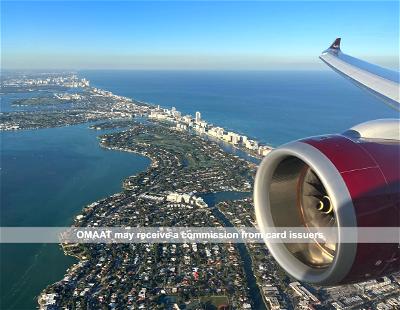Credit card benefits are constantly evolving, and it can be tough to keep track of which cards are best. In this post, I wanted to compare two of the most popular mid-range credit cards, both of which can be really worthwhile (and for many people it could even make sense to have both).
In this post:
Comparing the Chase Sapphire Preferred & Citi Premier
The Chase Sapphire Preferred® Card (review) and Citi Premier® Card (review) are two of my favorite cards with annual fees of under $100. In this post, I wanted to compare the two cards since I know many people try to figure out which of these two cards makes the most sense for them.
While the cards have a lot in common, there are also major differences between them. So let’s compare various aspects of the cards.
How do welcome bonuses compare?
Both cards offer huge welcome bonuses for new cardmembers:
- The Chase Sapphire Preferred is offering 60,000 Ultimate Rewards points after spending $4,000 within the first three months
- The Citi Premier is offering 60,000 ThankYou points after spending $4,000 within the first three months. Plus, for a limited time, earn a total of 10 ThankYou® Points per $1 spend on hotel, car rentals, and attractions (excluding air travel) booked on the Citi Travel℠ portal through June 30, 2024.
Winner: I value Ultimate Rewards points and ThankYou points roughly equally, so it is a toss up.

How do eligibility & approval odds compare?
Credit card issuers have all kinds of rules when it comes to approving people for new cards, and both of these cards have their fair share of restrictions.
The welcome bonus on the Chase Sapphire Preferred isn’t available to:
- Those who currently have the card, or who have received a new cardmember bonus on the card in the past 48 months
- Those who currently have the Chase Sapphire Reserve® (review), or who have received a new cardmember bonus on the card in the past 48 months
- Those who exceed Chase’s 5/24 limit, which would be those who have opened five or more new card accounts in the past 24 months
Meanwhile, the welcome bonus on the Citi Premier isn’t available to:
- Those who have received a new cardmember bonus on the Citi Rewards+, Citi ThankYou Preferred, Citi Premier, or Citi Prestige, in the past 24 months
- Those who have closed the Citi Rewards+, Citi ThankYou Preferred, Citi Premier, or Citi Prestige, in the past 24 months
Winner: While the answer will vary based on your specific situation, generally speaking, the Citi Premier is easier to be approved for. That’s because Citi doesn’t have a 5/24 rule, and also because you’re prevented from getting the Chase Sapphire Preferred if you have the Sapphire Reserve. With Citi, the key is just that you haven’t opened or closed one of four cards in the past 24 months (it’s fine to have one of those cards, you just can’t get a welcome bonus or close a card in that period).
How do annual fees compare?
The Chase Sapphire Preferred has a $95 annual fee and Citi Premier has a $95 annual fee, neither of which are waived for the first year. On both cards, you can add authorized users at no extra cost.
Winner: This is a tie since both cards have the same annual fees.
How do bonus categories compare?
Both cards offer bonus categories for purchases that are popular with consumers, but the rewards structures are very different.
The Chase Sapphire Preferred offers the following rewards structure:
- 5x points on travel booked through the Chase Travel Portal
- 3x points on dining purchases
- 3x points on online grocery purchases
- 3x points on select streaming services
- 2x points on travel purchases
- 1x points on all other purchases
- 10% anniversary bonus points based on how much you spend (so if you spend $10,000 in a year, you’d get 1,000 bonus points)
The Citi Premier offers the following rewards structure:
- 3x points on dining purchases
- 3x points on grocery store purchases
- 3x points on gas station purchases
- 3x points on airfare purchases
- 3x points on hotel purchases
- 1x points on all other purchases
Winner: It depends on your spending patterns, but I think the Citi Premier’s bonus categories are more well-rounded. That being said, the Chase Sapphire Preferred has improved significantly in this area, and is now much more competitive. In particular, both cards are excellent for dining purchases.

How does rental car & travel protection compare?
One potential perk of getting a travel rewards card is valuable travel protection:
- The Chase Sapphire Preferred offers primary rental car collision damage waiver coverage both in the US and abroad, and excellent flight delay, trip cancelation, and lost baggage coverage
- The Citi Premier doesn’t offer rental car and other travel protection benefits, so the card isn’t particularly competitive in that regard
Winner: The Chase Sapphire Preferred wins by a long shot, because it offers excellent travel coverage, while the Citi Premier doesn’t.

How do annual hotel credits compare?
Both cards now offer annual hotel credits, though the terms associated with them differ:
- The Chase Sapphire Preferred offers a $50 anniversary Ultimate Rewards hotel credit — make a hotel booking through Ultimate Rewards, and you’ll receive a statement credit for up to $50 (there’s no minimum spending amount required, so you could in theory book a $50 hotel room and get a $50 credit)
- The Citi Premier offers a $100 annual Citi ThankYou hotel credit — make a hotel booking of at least $500 through the Citi ThankYou portal, and you’ll receive a statement credit for up to $100
While these credits are nice perks, one thing to keep in mind is that often you’ll find lower prices through other booking sources. On top of that, if you’re staying at a hotel with a loyalty program, generally, third-party bookings (like those through Chase Ultimate Rewards or Citi ThankYou) won’t earn you points, elite benefits, etc.
Winner: This is a toughie, and I’d say it’s more or less a draw. The Citi Premier credit is bigger but also requires spending a lot more, while the Chase Sapphire Preferred credit doesn’t have a minimum. Would you rather get a $50 hotel credit with no minimum, or 20% off a $500 hotel stay?

How does the value of points compare?
Both Chase Ultimate Rewards and Citi ThankYou have transfer partners, and also let you redeem points as cash toward the cost of travel purchases.
Chase Ultimate Rewards points earned through the Chase Sapphire Preferred:
- Can be redeemed for 1.25 cents each toward the cost of a travel purchase through the Chase Travel Portal
- If you instead have the Chase Sapphire Reserve, points can be redeemed for 1.5 cents each toward the same purchases
- Can be transferred to the below airline and hotel partners
Airline Partners | Hotel Partners |
|---|---|
Aer Lingus AerClub | IHG One Rewards |
Air Canada Aeroplan | Marriott Bonvoy |
Air France-KLM Flying Blue | World of Hyatt |
British Airways Executive Club | |
Emirates Skywards | |
Iberia Plus | |
Singapore Airlines KrisFlyer | |
Southwest Rapid Rewards | |
United MileagePlus | |
Virgin Atlantic Flying Club |
Citi ThankYou points earned through the Citi Premier:
- Can be redeemed toward the cost of an airfare purchase at the rate of 1.0 cents per point
- Can be transferred to the below airline and hotel partners
Airline Partners | Hotel Partners |
|---|---|
Aeromexico Club Premier | |
As far as transfer partners go, in the past, I may have said that Ultimate Rewards points were worth a bit more than ThankYou points, but I no longer think that’s the case. Chase lost Korean Air SkyPass as a partner several years back, and Citi has added partners and also offered quite a few transfer bonuses.
I value both Chase Ultimate Rewards and Citi ThankYou points at 1.7 cents each.
Winner: While I personally value the points currencies roughly equally, I think Chase probably has the slight edge, thanks to the higher “cash-out” value of points toward travel purchases.

How do card ecosystems compare?
One of the great things about getting a card that belongs to one of the major transferable points currencies is that there are card ecosystems that can really help you maximize points. In other words, you can get multiple cards that complement one another to maximize your rewards.
Chase Ultimate Rewards arguably offers the most robust points ecosystem. For example, you could complement the Chase Sapphire Preferred with the Ink Business Preferred® Credit Card (review), which is a $95 annual fee card that offers 3x points on the first $150,000 of combined purchases per cardmember year on travel, shipping purchases, internet, cable, phone services, and advertising purchases made with social media sites and search engines.
You could also complement the Sapphire Preferred with any of the following no annual fee cards to really maximize your points earning potential:
- The Chase Freedom FlexSM (review) offers 5x points in rotating quarterly categories, on up to $1,500 of spending per quarter, plus 5x points on travel purchases through Chase Ultimate Rewards, plus 3x points on dining and drugstores
- The Chase Freedom Unlimited® (review) offers 5x points on travel purchases through Chase Ultimate Rewards, plus 3x points on dining and drugstores, plus 1.5x points on everyday spending
- The Ink Business Cash® Credit Card (review) offers 5x points on the first $25,000 spent in combined purchases each anniversary year on cellular phone, landline, internet and cable TV services, plus 2x points on the first $25,000 spend in combined purchases each anniversary year on gas stations and restaurants
- The Ink Business Unlimited® Credit Card (review) offers 1.5x points on everyday spending

The Citi Premier does directly have great bonus categories that exceed those of the Chase Sapphire Preferred, and then there are three no annual fee cards that can help you maximize your ThankYou points earning potential:
- The Citi Double Cash® Card (review) offers 1% cash back when you make a purchase and 1% cash back when you pay for a purchase (in the form of ThankYou points), and in conjunction with the Citi Premier, rewards can be transferred to airline and hotel partners, which is a great opportunity; this is a way to earn two ThankYou points per dollar spent on everyday purchases
- The Citi Rewards+® Card (review) rounds up purchases to the nearest 10 points, and also gives you a 10% refund on redeemed points, for up to 100,000 redeemed points per year
- The Citi Custom Cash® Card (review) offers 5x points on your top eligible spending category every billing cycle (on up to $500 of spending), with categories including drugstores, fitness clubs, gas stations, grocery stores, home improvement stores, live entertainment, restaurants, select streaming services, select transit, and select travel
Winner: Chase really shines when it comes to the ability to create a portfolio of cards earning Ultimate Rewards points. Rather than only using one card to maximize points, you can use several cards, and you can pool points across them. That being said, Citi is quickly catching up in terms of being able to create a portfolio of cards, thanks to the potential of maximizing the Citi Premier, Citi Double Cash, Citi Rewards+, and Citi Custom Cash.

Bottom line
The Chase Sapphire Preferred and Citi Premier are among the best cards with annual fees of under $100. Which card is better really depends on your specific spending patterns, and what you’re looking for out of a card.
As you can see, while the annual fees on the cards are the same, otherwise there are quite some differences between them, and each card shines in different areas.
I guess to simplify my advice as much as possible, for a beginner looking for a single card, I think the Citi Premier is a great option. The card has better and more well-rounded bonus categories, it might be easier to get approved for, and the points give you a lot of flexibility. Complement it with the no annual fee Citi Double Cash, and you’ll also be earning 2x points on everyday spending.
I think the area where the Chase Sapphire Preferred really shines is if you’re looking to build a portfolio of cards, given the number of other cards that can potentially earn you tons of Ultimate Rewards points. With a recent refresh to the card, the spending bonuses are also much better, and that nicely complements the great travel and car rental coverage. The card is also offering a better bonus.
You can’t really go wrong with either, though. Given the bonuses being offered by both cards at the moment, I think there’s big value in applying for both cards and seeing how they work out for you.
Do you prefer the Chase Sapphire Preferred or Citi Premier?





I favor the Citi cards ecosystems more, if only for the fact that Chase has multiple overlapping bonus categories across its many cards, as well as only 1.5% back for otherwise unbonused spending. Citi on the other hand has 2% on unbonused spending with the Double Cash and 3% on multiple categories on the Premier. I think the 5% back with the Custom Cash is easier than rotating categories, and 10% rebate on redeemed points with the Rewards+ is a nice bonus.
That Citi stripped away so many features like rental car coverage, or trip delay protection makes their cards complete non-starters.
While I like the rewards structure of the Premier, and like the Double Cash, the transfer partners leave me shrugging. Sure, it would be great to have a heap of Qantas points, but I have nothing to merge with this card to get them. I was excited to get the card last year with the hope that AA would remain a transfer partner, but just haven’t been using it since that single transfer.
When...
While I like the rewards structure of the Premier, and like the Double Cash, the transfer partners leave me shrugging. Sure, it would be great to have a heap of Qantas points, but I have nothing to merge with this card to get them. I was excited to get the card last year with the hope that AA would remain a transfer partner, but just haven’t been using it since that single transfer.
When the Premier had a great sign-up bonus last year, many people had a hard time getting the card, and the CL was coming in quite low. They raised mine to a whopping 6.1K, but that’s still not enough to use as a serious travel card. Any reports on approval rates and CLs with the increased sub this year?